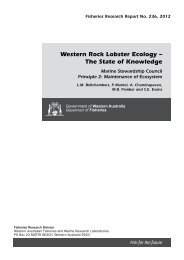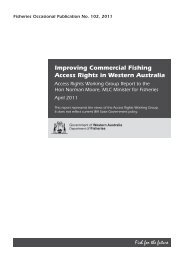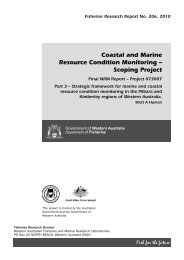Reproductive status5b5a 5c444362 21a1JTimeFigure 4.Developmental <strong>and</strong> maturation cycle <strong>of</strong> S. commerson ovaries showing the relativereproductive status <strong>of</strong> each ovarian stage through time. J; juvenile stage. 1 to 6; ovarianstages as detailed in Table 7 (without the ‘F’). The cross-hatched area indicates theperiod when immature (stage 1) <strong>and</strong> mature resting (stage 2) ovaries are most difficultto tell apart. Note that the duration <strong>of</strong> the non-spawning period (as indicated by stage 2ovaries) will be longer than depicted here.3.2 Staging system for macroscopic analysis <strong>of</strong> whole<strong>gonad</strong>sDescription <strong>of</strong> the initial macroscopic <strong>staging</strong> system used in the analysis <strong>of</strong> whole <strong>gonad</strong>s(ovaries <strong>and</strong> testes) is provided in Appendix B. Photographs <strong>of</strong> these stages are provided inPlates 1 to 24.3.2.1 Ovaries3.2.1.1 <strong>Assessment</strong> <strong>of</strong> the accuracy <strong>of</strong> macroscopic <strong>staging</strong>To determine the accuracy <strong>of</strong> the initial system for <strong>staging</strong> S. commerson ovaries, themacroscopic stage assigned to each ovary was compared with the histological stage given tothat same ovary (Figures 5). These data show that in most cases, the accuracy <strong>of</strong>macroscopic <strong>staging</strong> improved as personnel became more experienced (data for 1999compared to that for 2000), although the error rates were still greater than 40% for manystages. Breakdown <strong>of</strong> the data obtained during 2000 into the proportion <strong>of</strong> macroscopicallystaged ovaries in each histological stage identified where the errors were made (Figure 6).Fourteen percent <strong>of</strong> immature (F1) ovaries were wrongly classified as mature (F2 or 3) usingmacroscopic criteria. This could affect estimates <strong>of</strong> size at sexual maturity. A further 7% <strong>of</strong>F1 ovaries were classified as immature developing (F1a) although the consequences <strong>of</strong> thiserror are minor because these ovaries are still considered immature. Accuracy <strong>of</strong>macroscopic <strong>staging</strong> <strong>of</strong> F1a ovaries was low (30%). Seventeen percent <strong>of</strong> these ovaries were16 Fish. Res. Rep. West. Aust.2001, 136, 1-32
wrongly called F1, mainly because cortical alveoli stage oocytes were too small to be seenby eye. This would be <strong>of</strong> little consequence, however the erroneous classification 52% <strong>of</strong>F1a ovaries as either F2 or F3 could affect estimates <strong>of</strong> size at sexual maturity.Mature resting (F2) ovaries were uncommon during the periods selected for comparison <strong>of</strong><strong>staging</strong> <strong>systems</strong> <strong>and</strong> were correctly identified macroscopically, although some ovaries in<strong>other</strong> stages <strong>of</strong> development were incorrectly staged as F2. Examination <strong>of</strong> data obtainedduring <strong>other</strong> periods when F2 ovaries were more common suggests a 29% error rate for thisstage. Most <strong>of</strong> this error occurs when the ovaries are wrongly classed as F3, indicating thatlate perinucleolus stage oocytes are sometimes mistaken for early cortical alveoli stageoocytes. Errors in classification <strong>of</strong> mature developing (F3) ovaries may also be due todifficulties in identification <strong>of</strong> cortical alveoli oocytes – either because they were too smallto detect or because they were wrongly considered to be in the yolk globule stage. Thesemistakes are always likely to occur but should have minor affect on conclusions drawn fromthe data, except for those wrongly classified as F1a (9%) as these could influence estimates<strong>of</strong> size at sexual maturity.The accuracy <strong>of</strong> macroscopically classifying F4 ovaries was reasonable (81%). Most errorwas again due to misidentifying yolk globule as cortical alveoli stage oocytes, leading to 7%<strong>of</strong> the F4 ovaries being called F3. As before, this is likely to occur regularly in a smallnumber <strong>of</strong> cases but should have minimal effect on general conclusions. Five percent <strong>of</strong> F4ovaries were designated as F1a, perhaps because they were reaching sexual maturity for thefirst time <strong>and</strong> the yolk globule stage oocytes were wrongly thought to be in the corticalalveoli stage. Again, this could affect estimates <strong>of</strong> size at sexual maturity. Most (91%) F5aovaries were properly identified. Difficulty in macroscopically distinguishing oocytes in themigratory nucleus stage <strong>of</strong> development will always lead to some error in identifying thesefrom F4 ovaries (4% in this case), whilst a further 4% were classified as F5c. These errorsshould be <strong>of</strong> minor consequence for general description <strong>of</strong> spawning patterns.Spawning (F5b) ovaries were rare but unmistakable when present. Post-spawning (F5c)ovaries were difficult to reliably identify macroscopically because POFs cannot usually bedetected by eye. As a consequence, 18, 26 <strong>and</strong> 11% <strong>of</strong> F5c ovaries were called F4, F5a <strong>and</strong>F6, respectively. Identification <strong>of</strong> F6 ovaries is very unreliable because at the end <strong>of</strong> thespawning season many <strong>gonad</strong>s are flaccid <strong>and</strong> bloody even if they are still reproductivelyactive. Only in a few cases can mass atresia <strong>of</strong> the yolk globule stage oocytes be detectedmacroscopically.Data concerning the accuracy <strong>of</strong> macroscopically <strong>staging</strong> ovaries that have been frozen or onice for several days is limited (n = 80 for all stages combined), <strong>and</strong> confounded by the factthat histological analysis <strong>of</strong> frozen ovaries is also prone to error. Generally though, this dataindicates that breakdown <strong>of</strong> oocytes leads to confusion between stages 1a, 2 <strong>and</strong> 3, <strong>and</strong>between stages 4, 5a-c <strong>and</strong> 6.3.2.1.2 Development <strong>of</strong> a more accurate macroscopic <strong>staging</strong> systemGiven the above assessment <strong>of</strong> error sources, accuracy <strong>of</strong> the macroscopic <strong>staging</strong> systemwas improved by pooling stages 1a, 2 <strong>and</strong> 3 together (as F2-3), stages 4, 5c <strong>and</strong> 6 together(as F4), <strong>and</strong> stages 5a <strong>and</strong> b together (as F5; Figure 7). Stage 1 was retained as previous (asF1). This resulted in a simpler <strong>and</strong> more reliable macroscopic <strong>staging</strong> system that provides aquick <strong>and</strong> cheap means <strong>of</strong> determining sex <strong>and</strong> general maturation cycle <strong>of</strong> the ovary(Table 8).Fish. Res. Rep. West. Aust. 172001, 136, 1-32
















